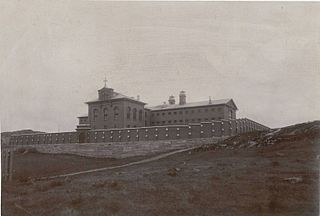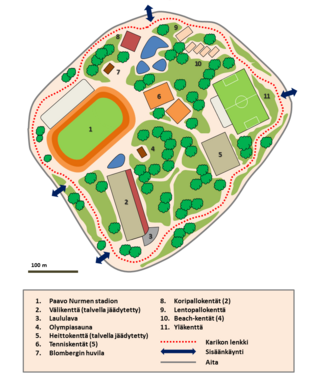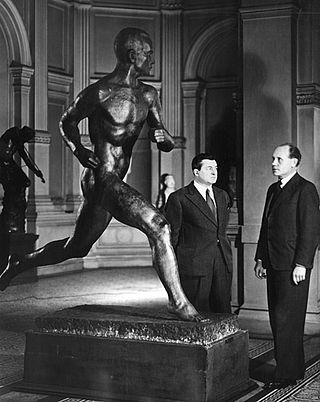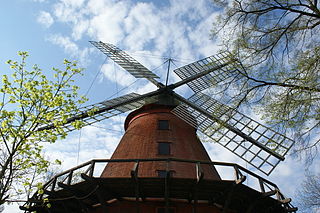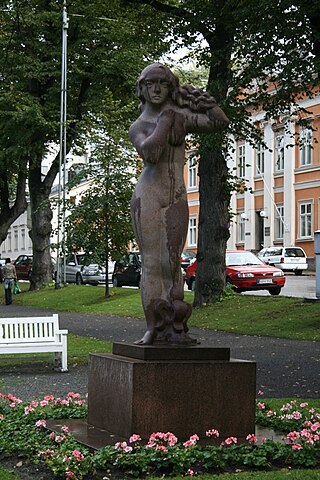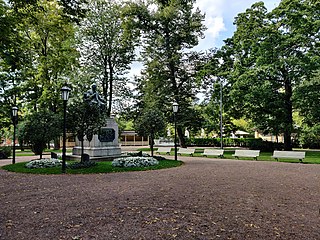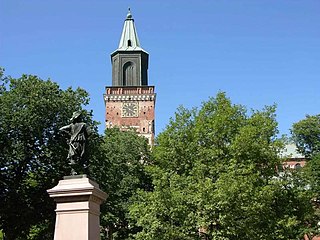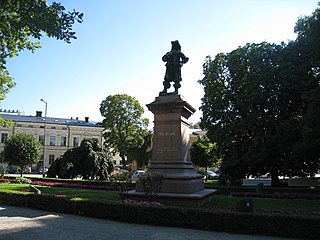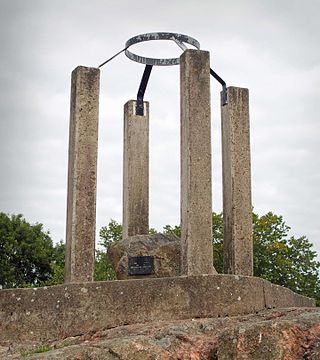Self-guided Sightseeing Tour #2 in Turku, Finland
Legend
Tour Facts
11.1 km
0 m
Experience Turku in Finland in a whole new way with our free self-guided sightseeing tour. This site not only offers you practical information and insider tips, but also a rich variety of activities and sights you shouldn't miss. Whether you love art and culture, want to explore historical sites or simply want to experience the vibrant atmosphere of a lively city - you'll find everything you need for your personal adventure here.
Activities in TurkuIndividual Sights in TurkuSight 1: Kakolanmäki
Kakolanmäki is a hill located in the central area of Turku, which is one of the seven hills of Turku. Until 2007, Turku Prison Central Prison and County Prison operated on the hill.
Sight 2: Portsan pojat
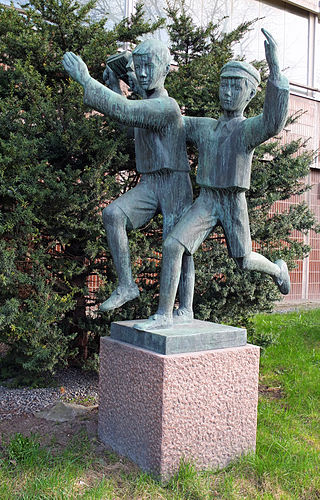
Portan pojat is a bronze sculpture by Viljo Mäkinen in the VIII district of Turku, or "Porsta", at Puutarhakatu 34.
Sight 3: Mikaelinkirkko
Michael's Church is a church situated in central Turku. It is named after Archangel Michael and was finished in 1905. It dominates the western skyline of the city of Turku. It was designed by Professor Lars Sonck and is one of the most popular wedding churches in Turku, being able to seat 1,800 people. When Sonck won the competition for the church in 1894, he was only a 23-year-old architectural student. Michael's Church is older than Michael's parish. The parish only dates back to 1921.
Sight 4: Turun helluntaiseurakunta
Turku Pentecostal Church is a Pentecostal revival church in Turku. The congregation has about 1,600 members. The congregation was founded with 69 founding members in 1921. The first missionaries left the congregation as early as 1929 for Manchuria.
Sight 5: Kimono
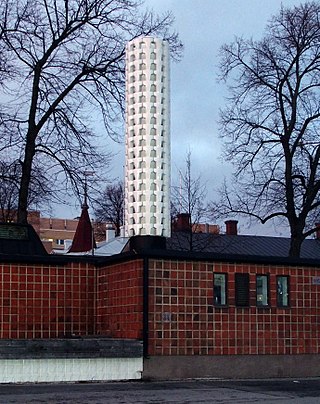
Kimono is Karin Widnäs' ceramic artwork by the Aura River in Turku. The tower of the wastewater pumping station is clad with ceramic tiles, the shape of which gives the work the name Kimono. It changes its color slowly according to the rhythm of the day, from blue through purple to dawn pink. Kimono was unveiled on the opening day of Turku's Capital of Culture year on 15.1.2011.
Sight 6: Jäinen meri

The Icy Sea is a bronze sculpture by Raimo Utriainen in Turku's Borenpuisto park between Linnankatu and Aurajoki, on the corner of Koulukatu and near Myllysilta. The sculpture, unveiled in 1961, was erected by the City of Turku as a memorial to winter navigation in Turku. The name August Uppman is engraved on the pedestal of the sculpture. He was a sea captain who founded the Steamship Company Bore. Boren Park, where the sculpture is located, and the nearby Bore House across School Street are also named after the company.
Sight 7: Gaian silmä

Gaia's Eye (1998) is a light installation by Kimmo Ojaniemi embedded in the wall of Turku's Myllytunnel using glass, acrylic, stainless steel and fluorescent tubes. The work is based on James Lovelock's Gaia hypothesis, conceived in the 1960s, according to which the Earth is a self-directed entity capable of keeping our planet suitable for habitation. In Greek mythology, Gaia is a goddess whose mission is to protect life and the Earth.
Sight 8: Urheilupuisto
Turku Sports Park is a sports and recreation area located in the centre of Turku, on the eastern bank of the Aura River. The extensive park area includes several sports facilities, some of which are open all year round. The most significant areas of the park are the Paavo Nurmi Stadium and the upper field, which serves as both a football and American football field. The park also has a disc golf course, outdoor exercise equipment, and several tennis, basketball and volleyball courts. In winter, the park's fields are frozen for ice games. The park is surrounded by the Karikon lenkki fitness track, named after Paavo Karikos, who was Finland's first municipal sports instructor from 1938 to 1969.
Sight 9: Samppalinnan tuulimylly
Samppalinna Windmill is a windmill in Turku, completed in 1860, which today is one of the city's attractions. Samppalinna Summer Theatre operates in the vicinity of the mill.
Sight 10: Soihtu
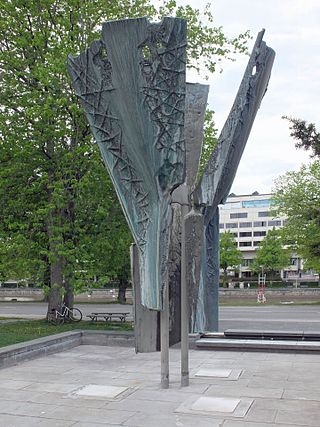
Torch is a fountain sculpture designed by Terho Saki and unveiled in 1975. It is located in front of the Government Office Building in Turku.
Sight 11: Aleksis Kivi
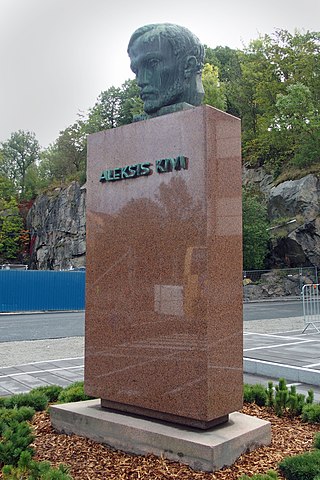
The Aleksis Kivi memorial in Turku is a bronze statue designed by sculptor Wäinö Aaltonen along Itäinen Rantakatu.
Sight 12: Turku City Theatre
Turku City Theatre is a theatre in the City of Turku. It was founded in 1946, when "Turun Teatteri" and "Turun Työväen Teatteri" merged. It was the oldest fully municipality owned theatre in Finland, until 2014, when it became a joint-stock company owned by the City of Turku.
Sight 13: Network
Get Ticket*Network is an environmental artwork designed and manufactured by architect Outi Sarjakoski in Turku, Turku, at the intersection of Itäinen Rantakatu and Volter Kilven katu. The size of the "cobweb" is about 12×15 meters. Sarjakoski braided the net himself from polyester rope, which took about one kilometre for the work.
Sight 14: Turun Linnantontun ja Valpuri Innamaan kohtaaminen Teatterisillalla
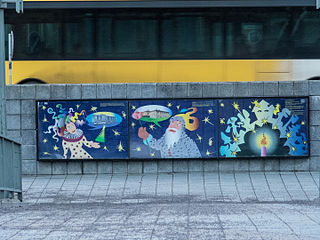
The meeting between Turku Castle Elf and Valpuri Innamaa at Theatre Bridge is a three-part environmental artwork created by Turku-based sculptor Jan-Erik Andersson at Turku Theatre Bridge. The work was completed in 1998, the bridge the previous year. The work is part of the Pro Cultura Foundation's environmental art project.
Wikipedia: Turun Linnantontun ja Valpuri Innamaan kohtaaminen Teatterisillalla (FI), Website
Sight 15: Suojattu kasvu
Protected Growth is a granite sculpture located on the west bank of the Aura River in Turku, created by sculptor Jarkko Roth from Vehmaa. The work, completed in 1983, was donated to the city by Rakennusliike Kivikartio in connection with its 40th anniversary celebration in 1985. Pauli Lappalainen, the founder of Kivikartio, said that the work depicts the sheltered growth environment that the steadily developing Turku offers to a company striving forward.
Sight 16: Pilvet

Pilvit is a three-part steel sculpture by visual artist Mika Natri in Turku on the banks of the Aura River, at the intersection of Ursininkatu and Läntinen Rantakatu.
Sight 17: Poika ja meri
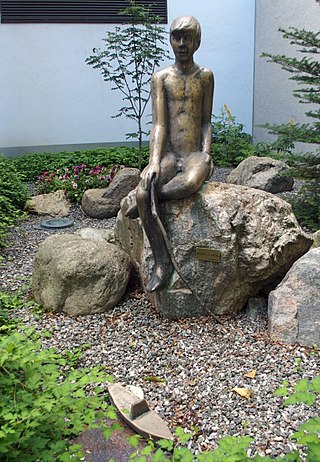
The Boy and the Sea is a bronze statue made by sculptor Simo Helenius. It is located in As. Oy Auranranta courtyard in Turku at Linnankatu 34. The statue was unveiled in 2005.
Sight 18: Kauppa, Teollisuus ja Säästäväisyys
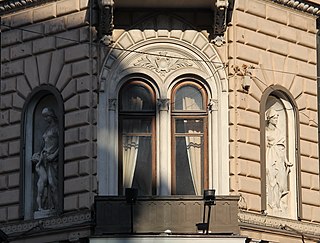
Commerce, Industry and Frugality are three sculptures made by Emil Wikström for Turku Savings Bank, which were placed on the façade of the bank building in 1891.
Sight 19: Qwenselin talo

The Qwensel House is the oldest wooden house in Turku, Finland. It is bourgeois housing from the autarchic times that has survived in its entirety. The house was built approximately in the year 1700 in an area that was reserved for the nobility in the city plan made up by Per Brahe the Younger in 1652. Today, the Qwensel House operates as the Turku Pharmacy Museum and café.
Sight 20: Ikaros
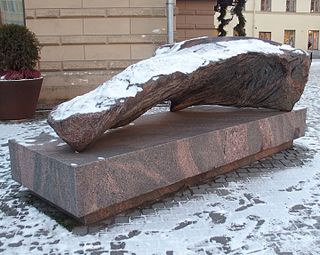
Ikaros is Laila Pullinen's first sculpture placed in a public space in Turku. The work was completed already in 2003 and was first exhibited at the Wäinö Aaltonen Museum. It was moved to its current location in front of Turku City Hall in 2012 to celebrate the 200th anniversary of City Hall.
Sight 21: Paavo Nurmi
The Paavo nurmi statue is a whole-body sculpture of runner Paavo Nurmi, the most successful Olympic athlete in Finland, made by sculptor Wäinö Aaltonen. The bronze sculpture was made in 1925 and there have been four additional casts of it. The statue has become a symbol for Finnish sport and the independent Finnish nation as well as an envoy of the image of Finland.
Sight 22: G. A. Petrelius, Äiti ja lapsi

The monument to G. A. Petrelius Mother and Child is a sculpture located in Samppalinnanpuisto Park in Turku. It was completed in 1914 and erected in memory of municipal councillor Gustav Albert Petrelius in 1915. The sculpture was designed by Felix Nylund.
Sight 23: Itsenäisyyden kivi
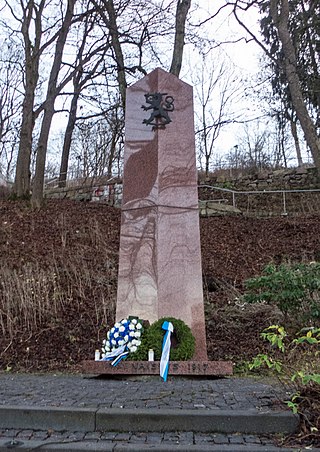
The Stone of Independence (1977) is a sculpture by sculptor Antti Louhisto, located on the slope of Samppalinna on Itäinen Rantakatu in Turku. The work is a quadrangular obelisk tapering upwards, the material of which Louhisto has used granite. At the top of the obelisk is the emblem of the State of Finland, the lion. The work was unveiled in connection with the 60th anniversary of Finland's independence on 6 December 1977.
Sight 24: Samppalinnanpuisto
Samppalinnanpuisto, also known as Samppalinnanvuori, is one of the parks in Turku. In the park are located e.g. Samppalinna restaurant, outdoor swimming pool and Luostarivuori school. Its plant range includes more than 60 different woody plant species. The name of the place derives from the ancient castle that was located on the site. In Southwest Finland, the word sampa or thrush has meant a boundary marker or pile.
Sight 25: Turun sotaveteraanien muistomerkki
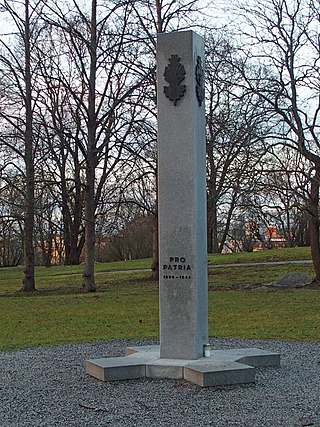
The Turku War Veterans Memorial is a sculpture designed by Aarne Ehojoki in Samppalinnanpuisto, Turku. The unveiling ceremony was in 1992.
Sight 26: Dominikaaniluostarin muistomerkki

Dominicans in Turku is a sculpture in front of the head office of Veritas pension insurance company in Kaskenmäki, Turku. The sculpture, made by Kimmo Ojaniemi, was unveiled in 2005, the centenary year of the Veritas company.
Sight 27: Lilja
Lilja is a red granite sculpture by Wäinö Aaltonen, located in Turku, Finland. It is located in Runeberginpuisto near the Aurasilta. It depicts the lily, the flower of the Turku coat of arms. In 1927, the statue was the first public art commission in Turku.
Sight 28: Kirjastosilta

The Library Bridge is a pedestrian and cycling bridge in Turku designed by Pontek Oy. Located at the city centre, the bridge crosses the Aura River connecting the streets Kauppiaskatu and Rettiginrinne. The bridge was opened for traffic in 2013, and it was named as the result of a public naming contest. The Turku Main Library is located near the bridge.
Sight 29: Tapaaminen Turussa 1812
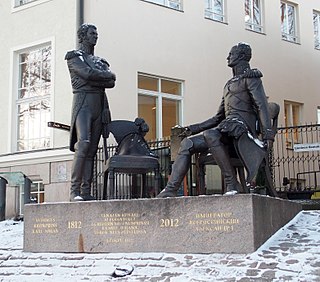
Meeting in Turku in 1812 is a bronze sculpture by Russian sculptor Andrei Kovalchuk on the banks of the Aura River in Turku at Läntinen Rantakatu 1 near Turku Main Library. It depicts a meeting between Emperor Alexander I of Russia and Crown Prince Charles John of Sweden in Turku in 1812. The work in question was commissioned jointly by the Russian Consulate and the City of Turku and initiated by Russians. The sculpture was unveiled during a seminar to celebrate the 200th anniversary of the case in 2012.
Sight 30: Suihkukaivo Leijona
G. A. Petrelius Fountain or Fountain Leijona is a fountain located in front of the old main library in Vähätori, Turku. The fountain, designed by Gunnar Finne and Armas Lindgren, was erected and donated to the City of Turku by Gustav Albert Petrelius' donation fund in 1924.
Sight 31: Kertosäe
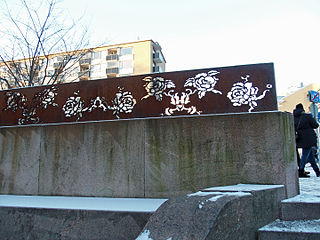
The chorus is a 14-metre artwork made of weatherproof corten steel by Saara Ekström on the edge of Vähätori Square in Turku. The art fence was commissioned to demarcate Vähätori from the busy Linnankatu street, and the fence runs parallel to Linnankatu, flanking the seating area created in front of the old main library. The work features symmetrically positioned rose ornamentation. Plant and flower motifs are recurring themes in Ekström's works. The chorus represents some kind of continuation of the vine theme of the G. A. Petrelius fountain next door.
Sight 32: Henrik Gabriel Porthan
The statue of Henrik Gabriel Porthan was unveiled on 9 September 1864 by Carl Eneas Sjöstrand. It is located in Turku's Porthaninpuisto park. The statue of H. G. Porthan is the oldest personal monument in Finland.
Sight 33: Porthaninpuisto
Porthaninpuisto Park is located in the centre of Turku between the Old Great Square and Brahenpuisto Park. It is named after Henrik Gabriel Porthan and houses a statue of Porthani. The park covers an area of 7,100 square meters.
Sight 34: Ajan virta
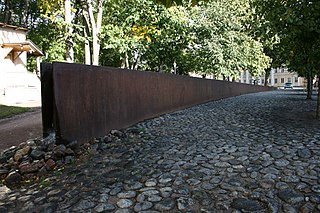
The River of Time is an environmental artwork designed by sculptor Kain Tapper and located in Turku's Old Great Square. The work was completed in 2000.
Sight 35: Old Great Square
The Old Great Square is a medieval market square located in the city centre of Turku, Finland. It is located in the II District in very close proximity to Turku Cathedral. The area was the administrative and commercial centre of Turku since the founding of the city in the 13th century up until the Great Fire of Turku.
Sight 36: Turun tuomiokirkon kortteli v. 1756
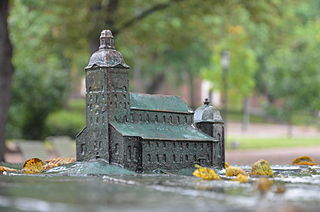
The Turku Cathedral block in 1756 is a sculpture made by Bruno Aspelin. It is located in Brahenpuisto in Turku.
Wikipedia: Turun tuomiokirkon kortteli v. 1756 (FI), Website
Sight 37: Brahenpuisto
Brahenpuisto Park is located in Turku between the Cathedral and Porthaninpuisto. The park is named after Peter Brahe. Brahenpuisto Park covers an area of 7,200 square metres.
Sight 38: Pietari Brahe
The Per Brahe statue is a monument of Per Brahe the Younger, the Governor-General of Finland and first chancellor of the Academy of Turku, located in Brahenpuisto in Turku, Finland. It was designed by Walter Runeberg and unveiled in 1888.
Sight 39: Kustaa II Aadolf

The statue of Gustav II Adolf is a statue of Gustav II Adolf located in front of the Academy House in Turku. The statue was erected in 1992 on the initiative of the Turku Court of Appeal, founded by Gustav II Adolf and operating in the Academy House. The statue was modelled on a statue of Gustav II Adolf by Swedish sculptor Bengt Erland Fogelberg in Gothenburg. The statue in Gothenburg was unveiled in 1854.
Sight 40: Turku Student Theatre
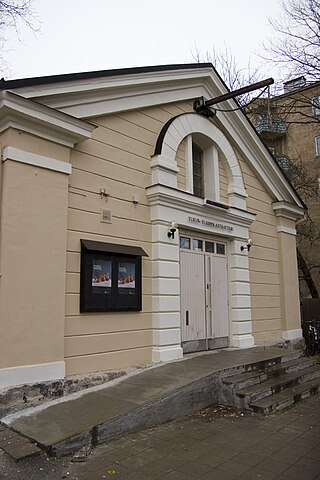
Turku Student Theatre is a Turku-based amateur theatre founded in 1959. The theatre produces 4–5 plays annually and a cabaret performance on May Day's Eve. The theatre has about 100 members and organises not only performances but also theatre training. Over the years, many theatre professionals and trendsetters have risen from the ranks of the theatre.
Sight 41: Elephant Square
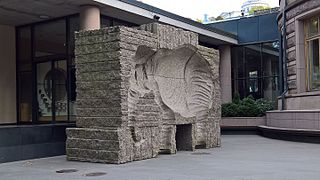
Norsuaukio is sculptor Hanna Vihriälä's solid granite sculpture standing in front of the Aboa Vetus & Ars Nova Art Museum in Turku. The work was commissioned by the Matti Koivurinta Foundation to celebrate the year of Turku's Capital of Culture and the 80th birthday of the museum's founder, Matti Koivurinna, and it was unveiled in September 2011.
Sight 42: Heikki Nurmio

The Heikki Nurmio statue is a sculpture in Turku's Vartiovuori Park, made by Kalervo Kallio in 1962.
Sight 43: Suolla
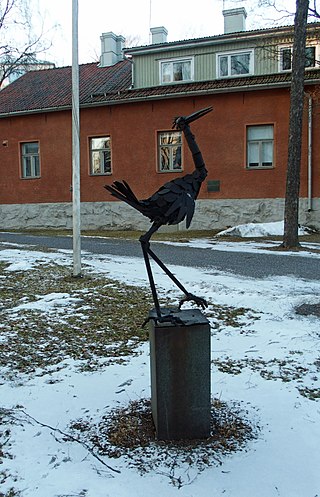
There is a sculpture by Veikko Haukkavaara in the yard of a daycare centre at Luostarinkatu 5 in Turku. The main material of the work is steel and iron elements, which Haukkavaara has welded together. The subject of the sculpture is a bird in a swamp that just seems to be taking a step forward. The unveiling took place in 1973.
Sight 44: Luostarinmäki
Luostarinmäki Handicrafts Museum is an open-air museum in Turku, Finland.
Sight 45: Vartiovuori Observatory

Vartiovuori Observatory is a former observatory in Turku, Finland. The observatory, designed by Carl Ludvig Engel, was originally built for the Royal Academy of Turku. The neoclassical building was completed in 1819. The observatory is situated atop the Vartiovuori hill, and it is clearly visible from different sides of the city centre.
Sight 46: Hirsipuumäen teloituspaikan muistomerkki
The memorial to the execution site of Hirsipuumäki was designed by Esko Hillilä in 1991. This is a project of the City of Turku by the museum's archaeologist Heljä Brusila and then city architect Jorma Aho. The memorial is located in Turku on Kerttulinmäki, next to Kerttul Upper Secondary School, on one of Turku's seven hills. Previously, the hill was known as Hirttomäki or Gallows Hill. A plaque on the monument bears inscription stating that the place was the place of execution of the city from the Middle Ages to the end of the 1700s.
Sight 47: Hirsipuumäki
Kerttulinmäki is a hill located in the first district of Turku. It is one of the seven hills of Turku.
Sight 48: Turun punavankileirin muistomerkki 535
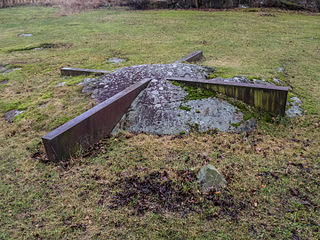
The memorial "535" of the Turku Red Prison Camp was designed by artist Ismo Kajander and executed by Reijo Möttönen, a metal teacher at the Turku Adult Education Centre, on the slope of Kurjenkaivonkenttä field in Turku. The artwork was unveiled in 1994 on the site where the Turku prison camp had been located after the Civil War. At its peak, there were 3300 Red prisoners in the camp, 175 of whom perished.
Wikipedia: Turun punavankileirin muistomerkki ”535” (FI), Website
Share
How likely are you to recommend us?
Disclaimer Please be aware of your surroundings and do not enter private property. We are not liable for any damages that occur during the tours.
GPX-Download For navigation apps and GPS devices you can download the tour as a GPX file.
